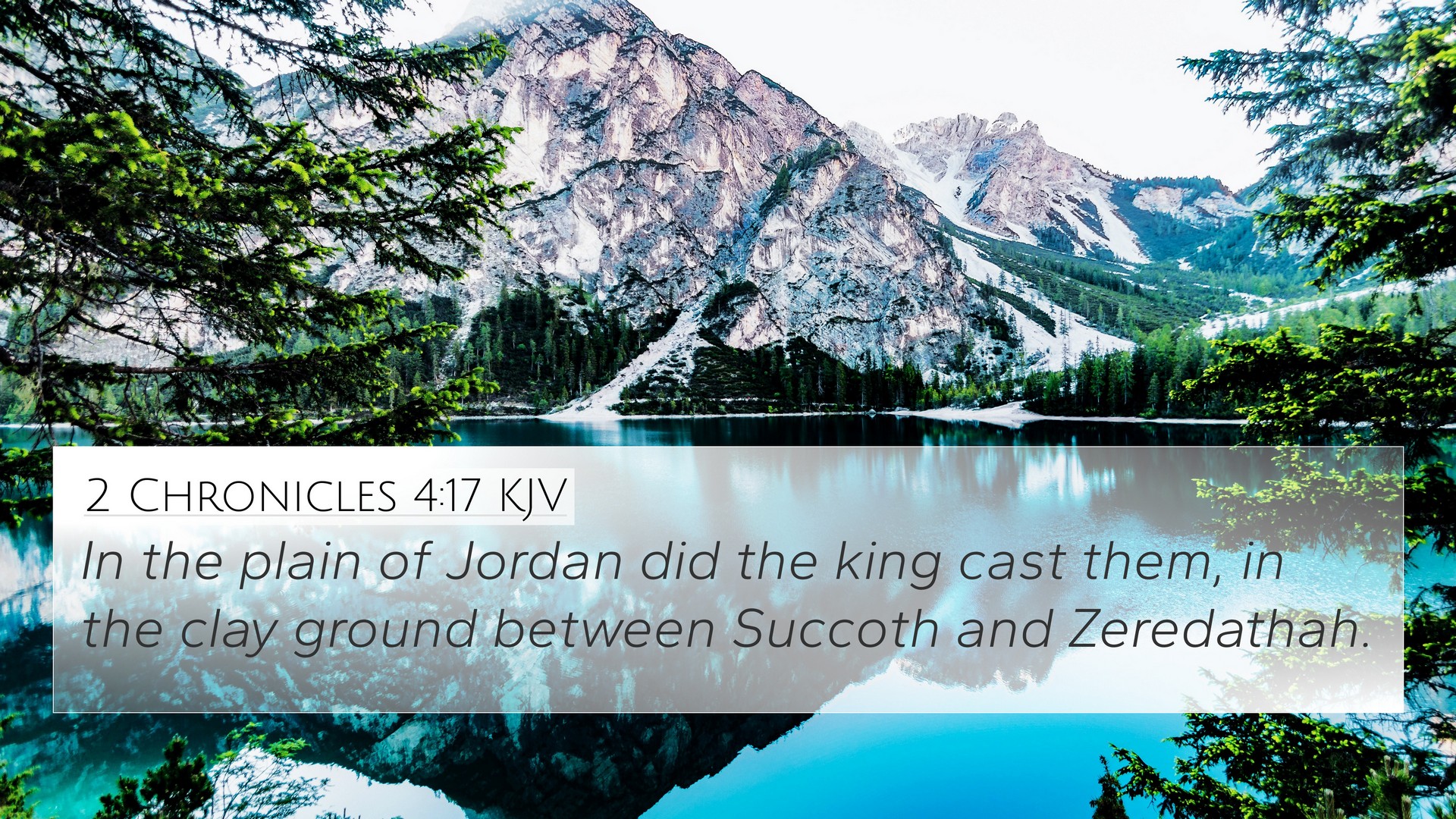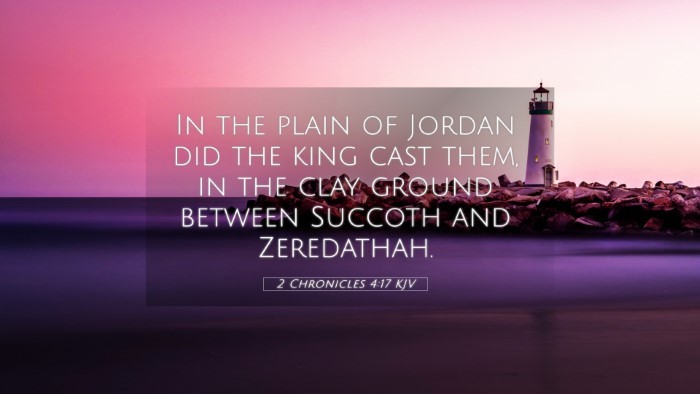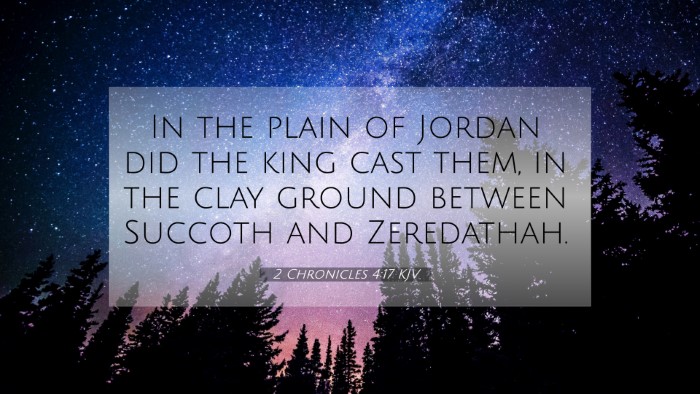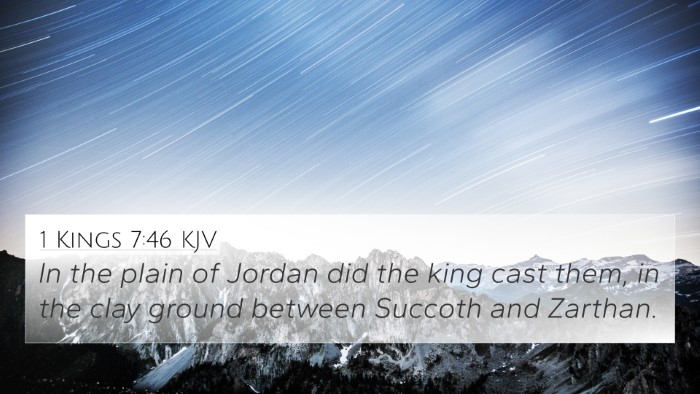Summary of 2 Chronicles 4:17
2 Chronicles 4:17 describes the creation of the great bronze altar that King Solomon had made for the temple services. The verse states:
"And he made a molten sea, ten cubits from the one brim to the other: it was round all about, and his height was five cubits: and a line of thirty cubits did compass it round about." (2 Chronicles 4:17, KJV)
Interpretation and Meaning:
- Cultural Significance: In the context of the Israelite worship system, the "molten sea" served as a significant basin for the priests to wash before their sacrificial duties. This emphasizes the need for purity and sanctification before approaching God.
- Dimensions and Design: The description provided indicates careful attention to detail in Solomon's construction efforts. The size and shape of the molten sea symbolize both grandeur and the importance of the temple as the center of Israelite worship.
- Symbolism of Water: The "sea" represents the cleansing power of God, reflecting both physical and spiritual purification necessary for worship. It points to New Testament themes where water symbolizes baptism and cleansing from sin.
- Historical Context: This verse occurs during David's son's significant undertaking of building the temple, distinguishing the period as a pivotal time in Israel’s history, marked by peace and prosperity under Solomon's reign.
Cross-References Related to 2 Chronicles 4:17
- 1 Kings 7:23-26 - Provides a parallel account detailing the construction of the molten sea, further highlighting the architectural brilliance of the temple.
- Exodus 30:18-21 - Refers to the bronze basin for the priests to wash, establishing a thematic link of purification in the worship system.
- Psalm 68:23 - Speaks to the imagery of cleansing, connecting God's deliverance with the concept of washing and purification.
- Ephesians 5:26 - Illustrates how Christ sanctifies the church, drawing parallels between physical and spiritual cleansing.
- Titus 3:5 - References the washing of regeneration, emphasizing the broader themes of purification and rebirth.
- Hebrews 9:13-14 - Discusses the comparisons between the sacrifice under the Old Covenant and the cleansing offered through Christ.
- Revelation 22:1 - Describes the river of life, which symbolizes eternal cleansing and the ultimate source of purification in heaven.
- Matthew 3:11 - John the Baptist speaks of water for repentance, linking back to the theme of purification seen in the Old Testament.
- John 13:10 - Jesus comments on the need for washing to symbolize physical and spiritual cleansing.
- James 4:8 - Encourages believers to “draw near to God," implying a need for purity and cleansing, resonating with the themes of ritual washings.
Comparative Analysis with Public Domain Commentaries:
According to Matthew Henry, the molten sea represents God's infinite grace, signified through the abundance of water available for cleansing. He notes that it illustrates the accessibility of God's forgiveness and mercy for attendees at the temple.
Albert Barnes expands upon the detailed measurements, indicating that these were not mere numerical values, but symbolical representation of God's perfection and order within worship. He emphasizes the need for a well-prepared place of worship that reflects divine glory.
Adam Clarke reflects on the ceremonial importance of such structures, indicating that they were not just functional, but deeply theological. The explicit designs remind the worshippers of the holiness of God, and the necessary steps taken to approach Him.
Conclusion:
The insights drawn from 2 Chronicles 4:17 open avenues for deeper understanding of scriptural themes. The melding of practical, ceremonial, and theological elements underscores the weightiness of God's presence among His people. Through cross-referencing these connections, one can appreciate the intricate relationship woven throughout Scriptures regarding purity, worship, and the character of God.
Exploring Biblical Themes through Cross-Referencing:
Utilizing tools for Bible cross-referencing can significantly enhance one’s understanding of the Scriptures. A Bible concordance allows users to find related themes and texts effectively. When employing a Bible cross-reference guide, it is essential to recognize how interconnected the texts are across both the Old and New Testaments.
Engaging with Scripture:
For those seeking to identify connections between specific Bible verses or engage in a detailed cross-reference study, it is beneficial to ask questions such as:
- What verses are related to 2 Chronicles 4:17?
- How do 1 Kings 7 and 2 Chronicles 4 connect?
- Which New Testament verses support the themes of cleansing found in the Old Testament?
In conclusion, understanding 2 Chronicles 4:17 through the lens of cross-references not only enriches one’s study of the Bible but also fosters an appreciation for the holistic narrative of God’s redemptive history.



